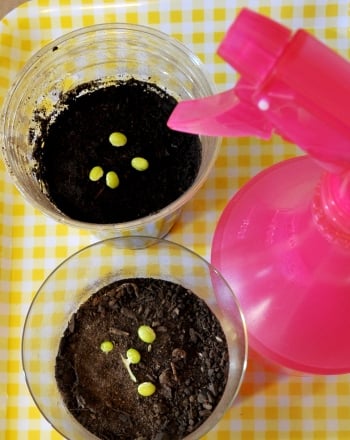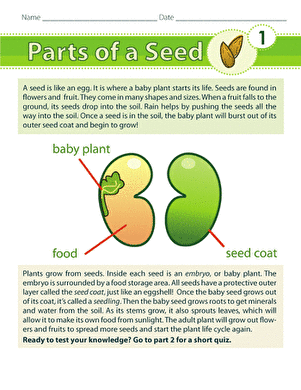Science project
Factors Affecting Seed Germination
What do plants need to grow? In this experiment, you’ll explore one of the most important factors affecting seed germination by finding out whether the amount of water a seed receives changes how quickly it germinates.
A seed contains the beginnings of a new baby plant. To grow, this plant needs water. Water helps a plant with different processes inside the plant. It allows the plant to move nutrients from the soil into its cells.
Problem
How does the variable of moisture affect seed germination?
Materials
- Potting soil
- 12 bean seeds
- 4 clear plastic cups
- Plant mister
- Permanent marker
- Distilled water
- Notebook
- Pencil
Procedure
- To set up the experiment, you’ll prepare four different soil samples. Save a small amount of soil from each batch so you can use it later.
- First, label one cup “Dry,” another “Moist,” another “Wet,” and another “Soaked”.
- Divide the potting soil into four equal parts. One part can go into the cup labeled Dry.
- Mist the second batch of potting soil with water until it is damp to the touch. Place this in the cup labeled “Moist”.
- Add water to the third batch of soil. It should be wet and slightly muddy to the touch. Place this batch of soil into the third cup.
- Add a lot of water to the fourth batch of soil. It should be soaking wet: When you squeeze it in your hand, water should come out. Place this batch of soil into the fourth cup.
- Plant four bean seeds in each cup. Place them gently on top of the soil near the edge of each cup. You should be able to see the seeds from the outside of each cup. Try to place them equal distances from each other. Cover them with ¼ inch of soil from the appropriate dry, moist, wet, or soaked pile.
- Create a hypothesis, your best guess about what is going to happen. Will the seeds from the different cups germinate at the same rate? At different rates? Why?
- Now, wait. Every day, look at the bean seeds. The seeds may begin to germinate. Use your notebook and pencil to take notes on what is going on with your bean plants from day to day.
- Do some seeds germinate more quickly than others? Do some not germinate at all? Why?
Results
The seeds germinate the best in moist soil.
Why?
What do seeds need to grow? Baby plants have fairly simple needs. They need good soil with nutrients, water, sunshine, and air, particularly carbon dioxide. However, the right mix of these essential elements for life can be surprisingly hard to find. If a seed falls in a place where there is very little light, it won’t grow at all or its growth will be stunted.
The same thing happens when a seed does not get a lot of water. Water is important to plants. When plants can get water from the soil, it’s easier for them to move soil nutrients into the plant tissues. Plants have a circulatory system just like you do. In your body’s circulatory system, your blood helps move food around your body. In plants, water works a lot like blood, helping the plant to move soil nutrients around. Plants also make food through a process called photosynthesis. This process involves light, water, and carbon dioxide. After photosynthesis, the plant needs to be able to move the food around inside itself. Water also helps keep the plant’s cells plump so that the plant stands tall.
Plants need water, but they don’t like to have too much water. Too much water can rot seeds before they get to grow. If you give soil too much water, the water fills in all of the air pockets in the soil. This means that your plant’s roots can’t breathe and get stressed. They may rot as well. For a plant, a little water is an amazing thing, but a lot can make it sick.
Education.com provides the Science Fair Project Ideas for informational purposes only. Education.com does not make any guarantee or representation regarding the Science Fair Project Ideas and is not responsible or liable for any loss or damage, directly or indirectly, caused by your use of such information. By accessing the Science Fair Project Ideas, you waive and renounce any claims against Education.com that arise thereof. In addition, your access to Education.com's website and Science Fair Project Ideas is covered by Education.com's Privacy Policy and site Terms of Use, which include limitations on Education.com's liability.
Warning is hereby given that not all Project Ideas are appropriate for all individuals or in all circumstances. Implementation of any Science Project Idea should be undertaken only in appropriate settings and with appropriate parental or other supervision. Reading and following the safety precautions of all materials used in a project is the sole responsibility of each individual. For further information, consult your state's handbook of Science Safety.











